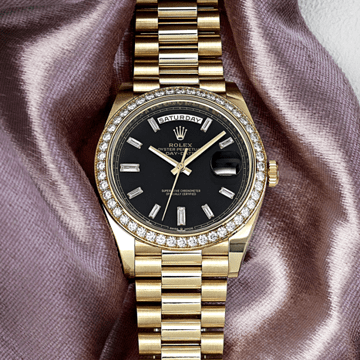The minute repeater is widely considered to be one of horology’s most prestigious complications, and the watches that feature this highly intricate mechanism are frequently accompanied by astronomical prices. While the vast majority of complications provide some type of additional visual display, a minute repeater appeals to a different one of the four human senses, and it offers users a sonic representation of the time, which it chimes out on a tiny set of mechanical gongs. With that in mind, the minute repeater is just one variant of the repeater complication, and below we are going to break down everything you need to know about minute repeater watches.
What Is a Minute Repeater Watch?
In watchmaking, a repeater is a specific type of complication that chimes the time on-demand using a tiny mechanical system of hammers and gongs. There are many different types of repeater mechanisms, although the minute repeater is easily the most popular, and a traditional minute repeater watch will chime two distinct sounds to play three different notes, with each one representing either the hours, quarter hours, or minutes. The approach and complexity of the chiming mechanism determines the type of repeater, and while basic styles such as quarter repeaters can only chime the hours and quarter hours, there are also a highly elaborate repeater mechanisms such as the Westminster Chimes (also known as Westminster Quarters), which plays four different notes in the key of E major to create an entire melody.
Activating a minute repeater is typically achieved by engaging a lever or button located on the side of a watch’s case, and the mechanism takes the information displayed by the dial and converts it into a sonic representation of the time, which it hammers out on its system of gongs. A traditional minute repeater plays a sequence consisting of a string of lower notes to represent the hours, followed by a two-note sound for the quarter hours (usually a high note quickly followed by a low note), and then ending with a series of high notes to signify the number of minutes that have passed since the last quarter hour. For example, a time of 3:38 would be expressed as “low, low, low, high-low, high-low, high, high, high” when played by a standard minute repeater, although the sound of the notes can differ from one timepiece to the next.
Luxury watch manufacturers go to great lengths to create pleasant-sounding minute repeaters, and the materials used for their hammers and gongs (along with the shape of the components themselves) can have a dramatic impact on the timbre of the sounds they produce. Additionally, the material used for the case of a minute repeater watch also influences its sound, with rose gold being a favorite among traditionalists due to the warmth that it adds to the notes. Similar to a finely crafted instrument, watchmakers tune repeater mechanisms to refine the sonic experience for their wearers, and due to their inherent complexity, even the most simple minute repeater watches are fundamentally expensive offerings that are celebrated by collectors for their ability to appeal to both our visual and auditory senses.
History of the Minute Repeater
The very first repeater mechanisms date back to clocks in the 1600s; however, it wasn’t until the late 1800s that a minute repeater was miniaturized enough to the point where it could fit inside the case of a wristwatch. Up until the post-WWI years of the 1920s, pocket watches remained the standard method of portable timekeeping among the general population, although decades before the proliferation of wrist-worn watches, Omega founder Louis Brandt created the world’s first minute repeater wristwatch in 1892, which featured an elegant gold case and a movement manufactured by Audemars Piguet.
A common fable within the world of horology is that the minute repeater was originally developed for the visually impaired and to help individuals reference the time in dark settings before the widespread use of electricity. While the functionality of a minute repeater could certainly be useful in such scenarios, repeater watches have always been rather expensive items that were out of reach for the average person, especially during an era when even a standard no-frills timepiece represented a fairly significant monetary investment. Rather than being created strictly for practical purposes like many of watchmaking’s other complications, the minute repeater has always been a micro-mechanical marvel for the wealthy, and the miniaturization of the minute repeater into a wrist-mounted format only made it all the more technologically impressive.
In the modern era, the minute repeater remains one of horology’s most prestigious complications, and due to the inherent complexity of a multi-note mechanical chiming device, minute repeater watches are typically only produced by high-end luxury manufacturers such as Patek Philippe, Audemars Piguet, Breguet, Jaeger-LeCoultre, and Vacheron Constantin. Additionally, while it is possible to find chiming watches priced at just a few thousand dollars, not all chiming watches are repeaters (let alone minute repeaters), and a timepiece that chimes a single note once per hour when the minute hand reaches the 12 o’clock marker is a far less complex mechanism than a true minute repeater, which offers on-demand access to the time, played with three distinct sounds for the hours, quarters, and minutes.
Types of Repeater Watches
Unlike timepieces with a "sonnerie au passage" complication that will autonomously chime a single note once per hour, repeater watches are defined by their ability to offer on-demand access to a sonic rendering of the time whenever their owners engage the button or lever on the side of their cases. The amount of information provided by the chiming mechanism defines the specific type of repeater, and while basic repeater watches are only capable of offering a rough approximation of the time, more advanced repeater mechanisms will play additional notes and be accurate to the current minute.
Quarter Repeater
The quarter repeater is one of the most simple repeater mechanisms, and it serves as the foundation for more advanced styles that expand upon its functionality. Quarter repeater watches typically chime out two separate notes, with a lower note dedicated to the hours, and a higher note (or a quick sequence of a high note followed by a low note) representing the number of quarter hours. Due to the fact that quarter repeaters only chime the number of quarter-hour intervals that have passed since the last hour, they are not able to offer an exact representation of the time, and closely related values such as 2:45 and 2:55 will sound the exact same because quarter repeater watches do not have a third note dedicated to the individual minutes.
Half-Quarter Repeater
A half-quarter repeater takes the core concept of a traditional quarter repeater mechanism and simply reduces the interval for its minutes recorder by half. Rather than tracking the number of quarter hours, a half-quarter repeater will chime notes for each interval of 7.5 minutes that have passed since the last hour. Although this approach objectively offers a greater degree of accuracy than a standard quarter repeater mechanism, measuring time in 7.5-minute increments isn’t necessarily the most intuitive, and you seldom see contemporary watches with half-quarter repeater complications.
Five-Minute Repeater
Operating similar to a quarter repeater or a half-quarter repeater but with a further reduction in the interval of its minutes recording mechanism, a five-minute repeater will chime out the value of the current hours, followed by a second note for every five minutes that have passed since the start of the hour. While a five-minute repeater still isn’t able to offer a sonic rendering of the exact time, it is far more accurate than a standard quarter repeater, and it is also quite a bit more intuitive than a half-quarter repeater. That said, the five-minute repeater is really just a stepping stone in the evolution of the repeater mechanism, and most of today’s top brand’s simply take things one step further and opt for a full-fledged minute repeater complication.
Among all of the various types of repeater mechanisms, the minute repeater is easily the most popular within the modern era, and it represents the final step in the evolution of the repeater concept (at least from a functional perspective), as more complex approaches simply offer a more elaborate rendering of the time, rather than a more accurate expression of it. Unlike more simplistic repeater mechanisms, a true minute repeater is capable of offering a complete sonic representation of the current time, right down to the exact minute. Similar to a standard quarter repeater, a minute repeater will chime out the current hours and quarter hours; however, after the quarter hours have been sounded, a minute repeater will then play the number of additional minutes that have passed since the last quarter hour.
Decimal Repeater
Also capable of offering a precise auditory rendering of the time, a decimal repeater works in a very similar manner to a minute repeater, with the one key difference being the way that it counts partial hours. Rather than recording quarter-hour increments, a decimal repeater counts the ten-minute intervals that have passed since the last hour, and the second set of tones in its chiming sequence will correspond with ten-minute intervals, rather than fifteen-minute intervals like a standard minute repeater. The primary purpose of decimal repeater is to offer a slightly more intuitive presentation of the time, although most of today’s luxury brand’s tend to favor the traditional minute repeater approach over this alternate method.
Grande Sonnerie
A grande sonnerie is a more elaborate expression of a repeater that is combined with a quarter or minute striking mechanism. On each quarter hour, a grande sonnerie watch will autonomously chime the current hours and quarters past the hour, and these quarter-hour chimes can either be standard repeater-style sequences consisting of high and low notes, or full melodies like the iconic four-note pattern played by a Westminster Chimes mechanism. Additionally, while a grande sonnerie will automatically trigger its quarter-hour sequence, it also includes the on-demand functionality of a repeater, and users can trigger its chiming mechanism via a button or lever to receive a precise sonic representation of the current time.
Famous Minute Repeater Watches
As one of watchmaking’s most highly regarded complications, the minute repeater has played a central role in numerous noteworthy timepieces throughout the years. Certain minute repeater watches keep the sole focus on their chiming capabilities, although it is not uncommon for brands to combine minute repeaters with multiple other functions to produce incredibly elaborate timepieces that are exponentially more complex than a standard repeater watch. Often grouped within the somewhat nebulous category of “grand complication” models, timepieces such as the Patek Philippe Grand Complications ref. 5208R-001 certainly are minute repeaters; however, this ultra-complex model is also a monopusher chronograph with a perpetual calendar and a moonphase display, and the repeater function represents just one of its flagship complications.
Patek Philippe World Time Minute Repeater
Combining two of the brand’s most emblematic complications, the Patek Philippe World Time Minute Repeater offers simultaneous access to all of the world’s major time zones, while also featuring a patented mechanism that will always chime the time in its current location. Fitted with intricate enamel dials and available in either 18k rose gold as the discontinued reference 5531R or 18k white gold as the current-production reference 5531G, the Patek Philippe World Time Minute Repeater offers an overall appearance that is rather similar to the brand’s standard World Time models. However, the lever on the 9 o’clock side of its case alludes to an entirely more advanced movement, and the automatic Caliber R 27 HU powering the watch perfectly merges the functionality of its two signature complications.
Audemars Piguet Royal Oak Minute Repeater Supersonnerie
The Royal Oak collection has significantly expanded since its debut in the 1970s, and it now includes models with a wide assortment of complications. Adhering to the same fundamental styling as the classic Royal Oak but in an enlarged format and with a symmetrical time-only dial, the Audemars Piguet Royal Oak Minute Repeater Supersonnerie features an extra-loud chiming mechanism that uses a dual-layer caseback to amplify the sound of its movement. As you would expect, Audemars Piguet has created multiple iterations of the Royal Oak Minute Repeater Supersonnerie, with notable examples being the titanium ref. 26591TI.OO.1252TI.03, the black ceramic ref. 26591CE.OO.D002CA.01, and the bi-metallic ref. 26591IP.OO.1252IP.01, which is adorned with a diamond-set bezel and crafted from both titanium and platinum components.
Patek Philippe Grand Complications 6301P-001
 Sitting right near the top of Patek Philippe’s repeater watch hierarchy (before you get into wildly elaborate offerings like the Grandmaster Chime and its extensive list of twenty different complications) is the Patek Philippe Grand Complications ref. 6301P-001, which combines a grande sonnerie with both a petite sonnerie and minute repeater. Crafted from platinum and fitted with a black Grand Feu enamel dial, the Patek Philippe Grand Complications 6301P-001 is powered by the 703-component Caliber GS 36‑750 PS IRM movement, and all of its features are exclusively dedicated to its chiming abilities, which makes the ref. 6301P-001 the ultimate expression of a Patek Philippe repeater watch.
Sitting right near the top of Patek Philippe’s repeater watch hierarchy (before you get into wildly elaborate offerings like the Grandmaster Chime and its extensive list of twenty different complications) is the Patek Philippe Grand Complications ref. 6301P-001, which combines a grande sonnerie with both a petite sonnerie and minute repeater. Crafted from platinum and fitted with a black Grand Feu enamel dial, the Patek Philippe Grand Complications 6301P-001 is powered by the 703-component Caliber GS 36‑750 PS IRM movement, and all of its features are exclusively dedicated to its chiming abilities, which makes the ref. 6301P-001 the ultimate expression of a Patek Philippe repeater watch.
















